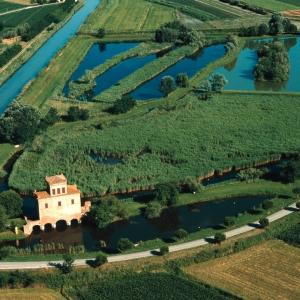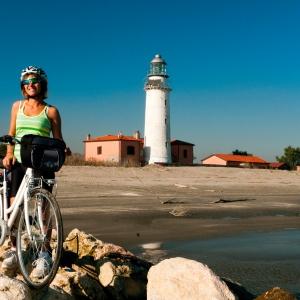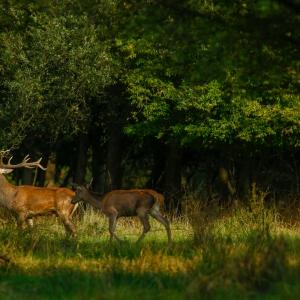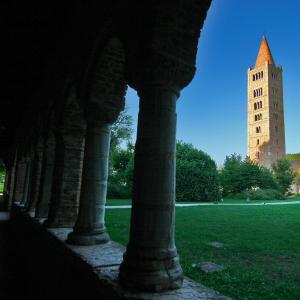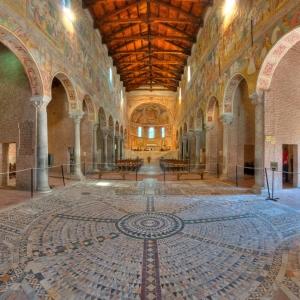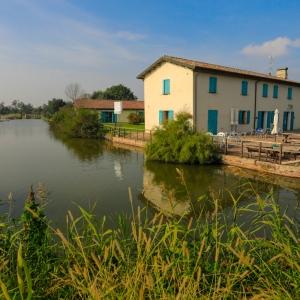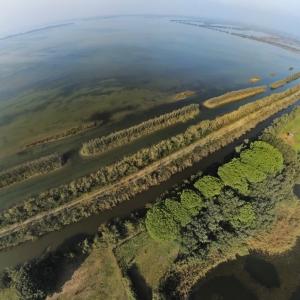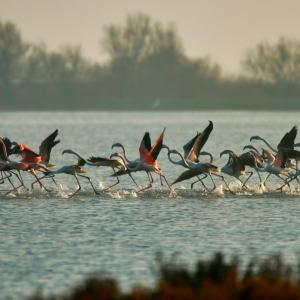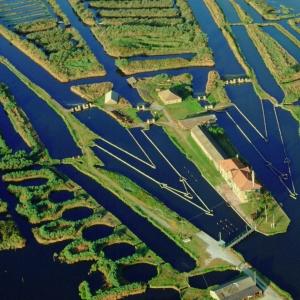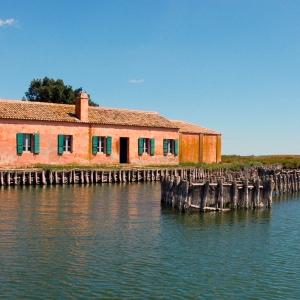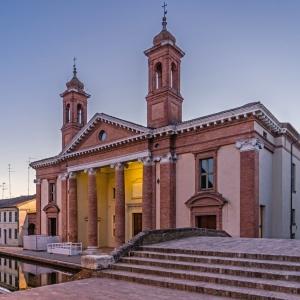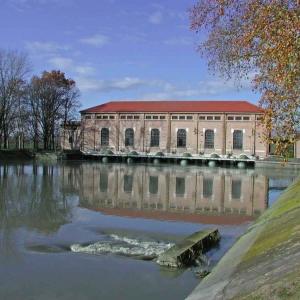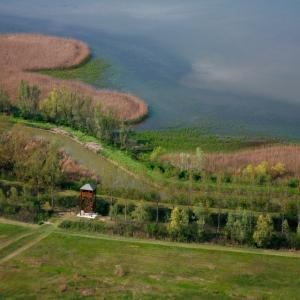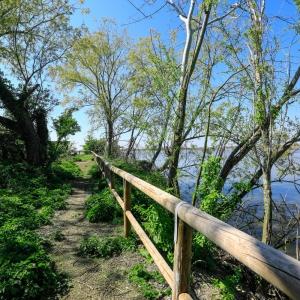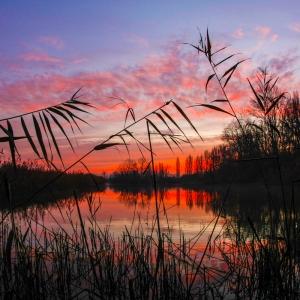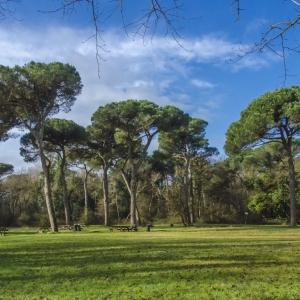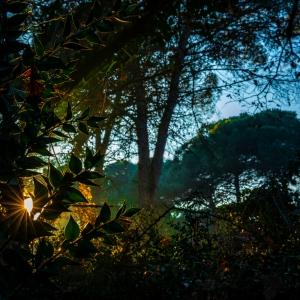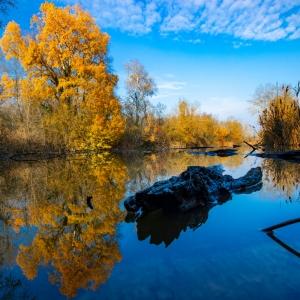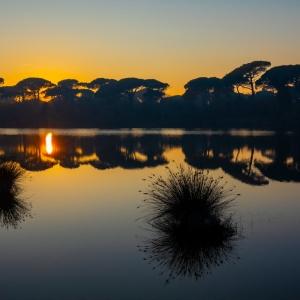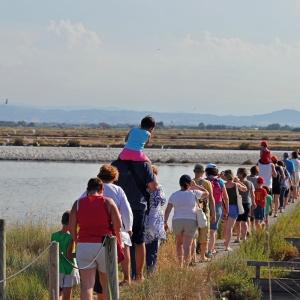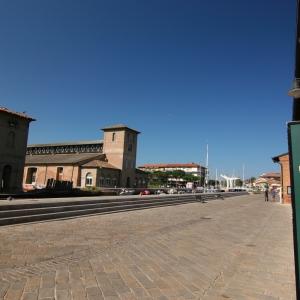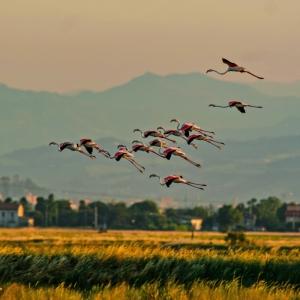BIRDWATCHING ITINERARIES
IN THE LAND OF THE ESTENSI
The itinerary starts in Mesola, an ancient estate belonging to the Estensi, where the sixteenth-century castle, which was recently opened as the Museum of Wood and Red Deer, still stands. A few kilometers from Mesola is the Riserva Naturale Orientata Dune Fossili di Massenzatica: this is the first stop for birdwatching. From here, following the directions first for the S.S. 309 Romea and then to Bosco Mesola, we reach the Riserva Naturale Bosco della Mesola, where you can stop for birdwatching or try to spot the King of the Wood: The Red Deer of the dunes. The wood is located near Torre Abate, an important example of hydraulic work dating back to 1569.
In the afternoon, it is possible to make a boat trip in the Sacca di Goro departing from Goro or Gorino or following the other instructions given previously. A stop in Valle Dindona is compulsorary as the location is and excellent site for bird observations. A little further on is a quaint pontoon bridge that joins the Emilian shores of the Delta to the Venetian side. A stop at the port of Gorino will enable you to understand the main economy of this area: the breeding of mussels and clams. In the local bakeries you can buy the “coppia ferrarese” a typical local bread recognized by the IGP mark, as well as biscuits to taste with wines produced in the sandy Delta country side. In spring you can buy the local wild asparagus.
ANCIENT STONES
This itinerary starts from Mesola, a pretty town on the edge of the S.S. 309 Romea, enriched by the mighty castle, one of the last Este estates and also a good land mark. Stay on S.S. 309, following signs to Ravenna, and arrive at the ancient Abbey of Pomposa, a site of great beauty and great historical and artistic importance that undoubtedly deserves a visit. After passing the Abbey on the left are the indications for Lido di Volano, a few kilometers later you arrive at the Oasi di Canneviè, the first stop of our trip that will engage most of the morning. The oasis also offers several options for dining, two restaurants and a bar for refreshments.
In the afternoon you can have multiple choice: the oasis is located adjacent to the Tower of Finance, buit in 1700 in order to maintain the armed defense of the port and to exercise control over the trades that took place at the mouth of this branch of the Po, a good place from which to watch over Valle Bertuzzi, the pine forest and the reeds of Po di Volano. On the other side of the river is the Lido di Volano, the board dedicated to this site contains all the necessary information and once in the car, continue along the scenic Acciaioli route that runs along the Valli Bertuzzi and the Lago delle Nazioni.
RIVERBANKS, BRIDGES AND CANALS
The starting point of this itinerary is the town of Comacchio. It’s worth stopping for a walk in the old town full of colourful houses and bridges that are reflected in the canals. Do not miss the Ancient Delta Museum and the Visitor Centre of Manifattura dei Marinati, the old factory where the fish of the lagoon was marinated, today it’s Slow Food presidium for the production of traditional marinated eel of the Valli di Comacchio. If you want to stop for lunch, you will find lots of places. Birdwatchers must get up early and go to Stazione Foce in the Valli di Comacchio, a few miles from town, and follow the recommended routes in the site description. In this area there is only one facility for lunch and refreshments.
The afternoon can continue between Oasi di Valle Zavelea, the Agosta embankment, the peninsula of Boscoforte and the Reno river bank along the southern portion of the Valli di Comacchio. The keenest birdwatcher, having taken the ferry along the Reno river to St. Alberto, may return to Comacchio along the S.S. 309 Romea, stopping for last sightings at Vene di Bellocchio and Valle Ancona. Before that, on the way back along the Romea road there is the fishing station Bellocchio with the characteristic “lavoriero” (triangular trap for fishing), where frequently there are several types of herons and gulls, including the Slender billed Gull.
RECLAIMED LAND
Starting from Comacchio, follow the signs to reach the Vallette di Ostellato. Once on the road “strada Nuovo Mondo”, after eight kilometres, you will find an area of environmental restoration consisting in a series of ponds with reeds and wet meadows that will surprise the birdwatcher. The Vallette di Ostellato is located at the entrance of the town of Ostellato and is equipped with various recreational facilities and accommodation. After visiting the Vallette, the route that we sujest involves the transfer to Bando, in order to visit the Oasi delle Anse Vallive di Porto - bacino di Bando. The reserve has regular opening hours, but even from outside you can see the flight of ducks and storks. During the winter it’s easy to spot flocks of Greater White-fronted Goose and Bean Goose grazing in the surrounding countryside. For lunch we recommend agritourisms and restaurants in the area offering excellent local menus.
The next step consists of Oasi Val Campotto and Oasi di Valle Santa, located near the town of Argenta. We also recommend visiting the Idrovora Saiarino, a nice example of industrial archeology, the Parish of St. Giorgio and the Museum of Valli di Argenta - Val Campotto. From Argenta you can return to Comacchio following the signs for San Biagio, Filo d’Argenta and Longastrino, a route that passes into the heart of Bonifica del Mezzano and reaches the Agosta bank along the western border of the Valli di Comacchio.
PINEWOODS AND FLOODED FORESTS
Ravenna is the ideal starting point to reach the surrounding natural areas and at the same time offers the opportunity to visit places of great historical and artistic importance such as the Basilica of St. Apollinare Nuovo, the Tomb of Dante and the Mausoleum of Galla Placidia. In some churches there is the possibility of birdwatching by admiring the mosaics! This trail takes you north of the city, immersed in nature, long walks and easy sightings. Once parked, the first stop is the Pineta di San Vitale, soon after you reach the Pialassa della Baiona, the visit will take the whole morning. Also the flora and fauna are stunning along this route. The same can be said about the adjacent flooded forest of Punte Alberete: extraordinary and beautiful in early spring when it flowers in yellow and white thanks to the Iris and the Snow Drops. It is also possible to see rare species here.
Back to the car we can end the day with a last look for Spoonbill and Glossy ibis, from the birdwatching tower of the Valle Mandriole.
MOSAICS AND SALT LAKES
Starting from Ravenna and taking the S.S. 16 Adriatica to the south, you arrive at Fosso Ghiaia, leaving the main road you enter the Pineta di Classe. A lovely trail takes you to a birdwatching tower and a hut that overlook Ortazzo. The Ortazzino, however, can be reached by car following the sujested directions. A visit of the pine forest is worth a while: the area is ideal for seing different botanical species and for biowatching. This route takes the whole morning: lunch solutions are many, and the veraiety of local dishes will satisfy every one!
In the afternoon the tour continues with a visit to the Salina di Cervia, the gateway to the south of the Po Delta Park, with several trails that allow you to admire an environment of extraordinary beauty and charm. Another point of interest is the Park of Salt-pans, where even today sea salt is produced, harvested and packaged in the traditional manner. The old salt cycle is demonstrated by the Salt-pans Camillone and by the seventeenth-century warehouses that host the Salt Museum.



